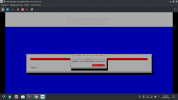We're very excited to announce the major release 8.0 of Proxmox Virtual Environment! It's based on the great Debian 12 "Bookworm" but using a newer Linux kernel 6.2, QEMU 8.0.2, LXC 5.0.2, and OpenZFS 2.1.12.
Here is a selection of the highlights of the Proxmox VE 8.0 final version
Release notes
https://pve.proxmox.com/wiki/Roadmap
Press release
https://www.proxmox.com/en/news/press-releases/
Video tutorial
https://www.proxmox.com/en/training/video-tutorials/item/what-s-new-in-proxmox-ve-8-0
Download
https://enterprise.proxmox.com/iso
https://www.proxmox.com/en/downloads/item/proxmox-ve-8-0-iso-installer-bittorrent
Documentation
https://pve.proxmox.com/pve-docs
Community Forum
https://forum.proxmox.com
Bugtracker
https://bugzilla.proxmox.com
Source code
https://git.proxmox.com
There has been a lot of feedback from our community members and customers, and many of you reported bugs, submitted patches and were involved in testing - THANK YOU for your support!
FAQ
Q: Can I upgrade latest Proxmox VE 7 to 8 beta with apt?
A: Yes, please follow the upgrade instructions on https://pve.proxmox.com/wiki/Upgrade_from_7_to_8
Q: Can I upgrade an 8.0 beta installation to the stable 8.0 via apt?
A: Yes, upgrading from beta to stable installation can be done via apt.
Q: Can I install Proxmox VE 8.0 on top of Debian 12 "Bookworm"?
A: Yes, see https://pve.proxmox.com/wiki/Install_Proxmox_VE_on_Debian_12_Bookworm
Q: Can I upgrade my Proxmox VE 7.4 cluster with Ceph Pacific to 8.0?
A: This is a two-step process. First, you have to upgrade Ceph from Pacific to Quincy, and afterwards you can then upgrade Proxmox VE from 7.4 to 8.0. There are a lot of improvements and changes, so please follow exactly the upgrade documentation:
https://pve.proxmox.com/wiki/Ceph_Pacific_to_Quincy
https://pve.proxmox.com/wiki/Upgrade_from_7_to_8
Q: Where can I get more information about feature updates?
A: Check the roadmap, forum, the mailing list, and/or subscribe to our newsletter.
__________________
Best regards,
Martin Maurer
Proxmox VE project leader
Here is a selection of the highlights of the Proxmox VE 8.0 final version
- Debian 12, but using a newer Linux kernel 6.2
- QEMU 8.0.2, LXC 5.0.2, ZFS 2.1.12
- Ceph Server:
Ceph Quincy 17.2 is the default and comes with continued support.
There is now an enterprise repository for Ceph which can be accessed via any Proxmox VE subscription, providing the best stability for production systems. - Additional text-based user interface (TUI) for the installer ISO.
- Integrate host network bridge and VNet access when configuring virtual guests into the ACL system of Proxmox VE.
- Add access realm sync jobs to conveniently synchronize users and groups from an LDAP/AD server automatically at regular intervals.
- New default CPU type for VMs: x86-64-v2-AES
- Resource mappings: between PCI(e) or USB devices, and nodes in a Proxmox VE cluster.
- Countless GUI and API improvements.
Release notes
https://pve.proxmox.com/wiki/Roadmap
Press release
https://www.proxmox.com/en/news/press-releases/
Video tutorial
https://www.proxmox.com/en/training/video-tutorials/item/what-s-new-in-proxmox-ve-8-0
Download
https://enterprise.proxmox.com/iso
https://www.proxmox.com/en/downloads/item/proxmox-ve-8-0-iso-installer-bittorrent
Documentation
https://pve.proxmox.com/pve-docs
Community Forum
https://forum.proxmox.com
Bugtracker
https://bugzilla.proxmox.com
Source code
https://git.proxmox.com
There has been a lot of feedback from our community members and customers, and many of you reported bugs, submitted patches and were involved in testing - THANK YOU for your support!
FAQ
Q: Can I upgrade latest Proxmox VE 7 to 8 beta with apt?
A: Yes, please follow the upgrade instructions on https://pve.proxmox.com/wiki/Upgrade_from_7_to_8
Q: Can I upgrade an 8.0 beta installation to the stable 8.0 via apt?
A: Yes, upgrading from beta to stable installation can be done via apt.
Q: Can I install Proxmox VE 8.0 on top of Debian 12 "Bookworm"?
A: Yes, see https://pve.proxmox.com/wiki/Install_Proxmox_VE_on_Debian_12_Bookworm
Q: Can I upgrade my Proxmox VE 7.4 cluster with Ceph Pacific to 8.0?
A: This is a two-step process. First, you have to upgrade Ceph from Pacific to Quincy, and afterwards you can then upgrade Proxmox VE from 7.4 to 8.0. There are a lot of improvements and changes, so please follow exactly the upgrade documentation:
https://pve.proxmox.com/wiki/Ceph_Pacific_to_Quincy
https://pve.proxmox.com/wiki/Upgrade_from_7_to_8
Q: Where can I get more information about feature updates?
A: Check the roadmap, forum, the mailing list, and/or subscribe to our newsletter.
__________________
Best regards,
Martin Maurer
Proxmox VE project leader
Last edited by a moderator:




